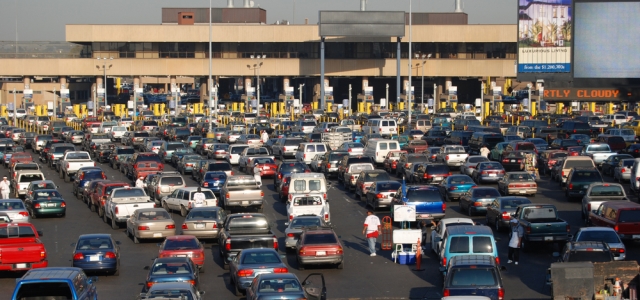 Ostensibly, the July 23rd hearing of the House Homeland Security Subcommittee on Border and Maritime Security was about the many differences between the Senate’s immigration-reform bill and the House’s border-enforcement bill. The hearing was even titled “A Study in Contrasts: House and Senate Approaches to Border Security.” However, while highlighting very real differences between the House and Senate approaches to immigration reform, the hearing inadvertently shed light on the many similarities between the two when it comes to border security. Both pieces of legislation embrace possibly unworkable border-enforcement goals that have more to do with unauthorized immigration than with the primary threats to border security: the transnational “cartels” that smuggle people, drugs, guns, and money in both directions across the border.
Ostensibly, the July 23rd hearing of the House Homeland Security Subcommittee on Border and Maritime Security was about the many differences between the Senate’s immigration-reform bill and the House’s border-enforcement bill. The hearing was even titled “A Study in Contrasts: House and Senate Approaches to Border Security.” However, while highlighting very real differences between the House and Senate approaches to immigration reform, the hearing inadvertently shed light on the many similarities between the two when it comes to border security. Both pieces of legislation embrace possibly unworkable border-enforcement goals that have more to do with unauthorized immigration than with the primary threats to border security: the transnational “cartels” that smuggle people, drugs, guns, and money in both directions across the border.
It goes without saying that the House and Senate are light years apart in many respects when it comes to immigration policy. On June 27, the Senate passed a comprehensive immigration reform bill—S. 744 (the Border Security, Economic Opportunity, and Immigration Modernization Act)—that aims to overhaul the entire dysfunctional U.S. immigration system. The House leadership, on the other hand, has so far opted for piecemeal reform in which a series of immigration bills would be passed, each addressing a different aspect of the immigration system. The most popular of these piecemeal bills so far has been H.R. 1417 (the Border Security Results Act), passed unanimously on May 15 out of the House Committee on Homeland Security. In contrast to S. 744, H.R. 1417 is an enforcement-only bill that does not acknowledge the existence of any other aspect of immigration reform.
Nevertheless, the border-enforcement provisions of S. 744 aren’t that different from those of H.R. 1417. Both bills share the arbitrary and possibly unworkable goals of “operational control” (a 90 percent deterrence rate) and 100 percent “situational awareness” along the entire southwest border. The Senate bill also added insult to injury in the form of the Corker-Hoeven (“border surge”) amendment, which seeks to micromanage border-security operations and would appropriate tens of billions of dollars in additional funding, and hire tens of thousands of additional Border Patrol agents, before the Department of Homeland Security has even determined what resource and staffing levels are needed to do the job.
The main problem with both bills, however, is that they are devoted primarily to deflecting unauthorized immigration to the United States, which is far from being the most significant threat to U.S. border security. Even though the bills acknowledge the security threat posed by smugglers, the primary metric by which border security is measured is the deterrence of unauthorized immigrants. Yet, as a number of border-security experts have pointed out, security is most effectively enhanced by focusing law-enforcement resources on dismantling the financial infrastructure and the leadership of the transnational criminal cartels that smuggle human beings and contraband across the border.
During the House hearing, some Members of Congress seemed to be confused about this distinction between criminal cartels that represent a security threat and unauthorized immigrants who do not. In her opening statement, for instance, Subcommittee Chairman Candice Miller (R-MI) lumped together “those who sneak across the border, across the desert, and those who overstay their visas” with “drug cartels and smugglers” who “continue to seek out the point of least resistance and succeed in coming into our country illegally by crossing our borders.” Similarly, in his testimony, Sen. John Cornyn (R-TX) spoke of unauthorized immigrants, contraband, and cross-border criminal organizations as if they were a single threat that had to be stopped by an impenetrable border.
In contrast, the testimony of Rep. Xavier Becerra (D-CA) reflected a more nuanced understanding of border security. He pointed out that the “greatest border security threats we face today come from Transnational Criminal Organizations (TCOs), not economic migrants crossing the desert.” He noted that “focusing the bulk of resources on apprehending unauthorized desert crossers has come at the cost of resources to prevent trafficking of humans, narcotics, currency, and counterfeit goods through our ports of entry.” And he lamented that, despite the comprehensive nature of Senate immigration reform bill, its “border security provisions were a tone-deaf response to the realities of our current state of border security and evidence that ‘more’ is not a substitute for ‘better.’”
Stopping unauthorized immigration is not the same as “securing the border,” and stopping unauthorized immigration requires reform of the U.S. immigration system as a whole. Likewise, taking down cross-border criminal cartels requires targeted enforcement, not putting an end to unauthorized immigration by somehow “sealing” the border. Deterring or capturing the unauthorized immigrants who are victimized by cartels may look good on a balance sheet, but it does not necessarily do anything to improve security.
FILED UNDER: Corker Hoeven Amendment, Hearings, immigration legislation, Senate


